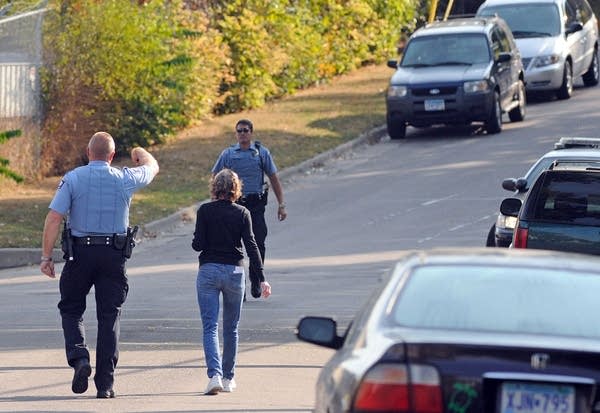Accent Signage workers' 911 calls failed to connect
Go Deeper.
Create an account or log in to save stories.
Like this?
Thanks for liking this story! We have added it to a list of your favorite stories.

Two employees tried to call 911 in the middle of the deadly shooting at Accent Signage Systems in Minneapolis last week, but the calls did not reach anyone, according to a police report released Friday.
Sheryl McAdams, who hid under her desk when she heard the first shots, tried to call 911, but the call "was unable to get through," the report said. She then called her boyfriend and asked him to call 911.
Eric Rivers, one of the employees shot by Andrew Engeldinger, asked a co-worker to call 911 because he "was bleeding out," the report said. The co-worker, Battites LaPage Wesley, told police he tried to call 911 but no one answered. The police checked Wesley's cellphone and it confirmed that he had tried to call 911.
The police report provides other new details about the terrifying rampage that left six people dead, including Engeldinger, who committed suicide. The killing began after supervisor Rami Cooks and director of operations John Souter told Engeldinger he was fired.
Turn Up Your Support
MPR News helps you turn down the noise and build shared understanding. Turn up your support for this public resource and keep trusted journalism accessible to all.
The meeting took place at 4:30 p.m. Sept. 27 in Souter's office. Engeldinger stopped at his car before the meeting. Keishia Wesley, who had stopped to pick up her husband from work, saw Engeldinger walk back inside to attend the meeting.
At the same time, she told police, a UPS truck pulled up to the loading dock.
Inside Souter's office, with the door closed, Engeldinger was fired. Engeldinger, who worked at the company since 1999, pulled a handgun out of a holster around his waist and began shooting, the report said.
The only words anyone heard him say, according to the report, came right after he learned he had lost his job.
"Oh really," he said, before reaching for his gun.
Cooks and Souter fought back. Engeldinger shot both of them. The struggle spilled out into the main office area, where company owner Reuven Rahamin stepped into the hallway.
Rahamim's assistant, Amanda Crotty, told police she heard gunshots, got up from her desk and walked toward the sound. She saw Engeldinger with a gun and Rahamim on the floor holding Souter. Without speaking, Engeldinger pointed the gun at Crotty. She hid under her desk.
Engeldinger shot Rahamim twice in the head at close range. Rahamim died at the scene.
Witnesses told police the shooter walked calmly through the building. He passed three female employees and did not fire any shots, but when he got to the company's sales area, he opened fire and killed employee Jacob Beneke.

Engeldinger continued into the loading dock area, where UPS driver Keith Basinski was in the back of his truck and two Accent Signage employees stood nearby.
Engeldinger shot employee Ronald Edberg twice in the head. He turned and fatally shot Basinski, the UPS driver, in the chest and arm. Police later found Basinski tucked into a corner in the back of his truck under some shelves.
Engeldinger looked at the third employee standing uninjured in the room and walked away.
He then entered the company's assembly area and resumed shooting.
One of the shots grazed the arm of an employee who suffered minor injuries. Another employee, Eric Rivers, was shot through a major artery in his thigh, causing massive blood loss.
Engeldinger walked down the basement stairs, sat down and shot himself in the head.
OFFICERS FIND BODIES AND POOLS OF BLOOD
The first police officer who arrived on the scene saw Wesley, one of the employees who tried to call 911, running from the back loading dock. Wesley told the officer that an employee was on a shooting rampage. Two more officers arrived, and as they approached the dock, they noticed a bullet hole in the front window of the UPS truck.
Then they found a man dead on the floor. The officers moved cautiously, thinking the shooter was still alive and inside the building. They saw another body in the hallway near the basement stairs. Then one of the officers heard someone moaning, and feared it could be the shooter trying to lure them closer.

One officer yelled in the direction of the moaning and ordered the person to come into the open with his hands clear. The injured man told the officer he couldn't move. As the officers followed the sound of the moaning, they passed a horrific sight -- the dead and injured lying in pools of blood.
Police found a man shot in the chest who was alive. They asked him for the name of the shooter. He mumbled the name "Andy" before falling unconscious.
When the officers reached the basement, they found Engeldinger dead in a chair with a gun by his right foot. On the opposite end of the basement, they found two employees who had barricaded themselves in a machine room.
LOOKING FOR ANSWERS
In the aftermath, buses arrived to take witnesses to the nearby police precinct. An officer said they appeared "obviously stressed and in disbelief that something like this could have happened at their place of work."
The witnesses called their families and were counseled by chaplains. At around 6 p.m., Engeldinger's mother, Carolyn Engeldinger, who had heard news of the shooting, called a police precinct to inquire about her son.
Meanwhile, a bomb squad at Engeldinger's house in south Minneapolis broke in through window. They later described the home as "cluttered" with vitamin bottles and beer cans.
They found a paystub on Engeldinger's nightstand. On his TV stand, police found a folder with paperwork about a discrimination lawsuit and a letter that Cooks, the Accent Signage supervisor who later fired him, sent Engeldinger about his persistent tardiness.
Employee Melissa Ritzer told police after the shooting that Engeldinger had "ongoing issues with two company executives." She said she believed that "Andy had filed a lawsuit against them and the business."
A search of available court records did not find any lawsuits involving Accent Signage or Engeldinger.

Police inspected Engeldinger's personnel file and found documents indicating he had problems producing quality work, showing up for work on time and dealing with other employees.
McAdams, the Accent Signage employee, told police that Engeldinger had anger problems but had been "unusually polite" in the days leading up to the shooting.
The morning of the shooting, McAdams decided to talk to Engeldinger because he seemed to be in such a good mood. She approached him around noon and said hello, but by that point, she told police, Engeldinger seemed to be in a bad mood.
"So she just let it go and believed Andy to be back to his old self again," the report said.
The killing began less than five hours later.
• Follow Madeleine Baran on Twitter: http://twitter.com/madeleinebaran




